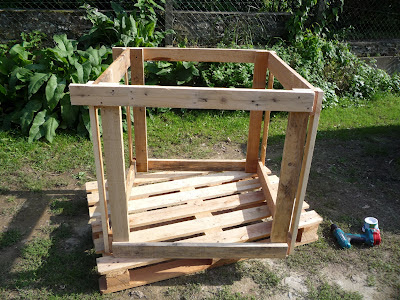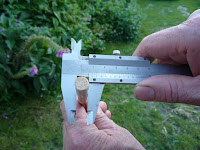It's been about two and a half years
since we set up our dry toilet system in the garden and it was only
the other day when I was looking through the Green Lever archive that I realised we had not written a post about the cabin and the seats. These will be long posts because there is a lot to share, so without further delay here is the first, the design, construction and assembly of the cabin (pictured below).
Introduction
 We've long been talking about
building our own Eco-house. Much of the work we've done in restoring
the 300 year old Longère in which we now live, has been experimental in trying out
more environmentally-friendly techniques and using ecological
materials. Our Eco-house is to be completely off-the-grid
including being autonomous with our own water supply. This being the
case, reducing water consumption is essential and the biggest
consumer of our water is the flush toilet. We also decided to have an extra liquids only toilet in the house and so, except for offering the choice to visitors, our flush toilet became totally redundant. In Setting up a dry toilet, which we wrote back in July 2012, we posted our water bills, showing how our consumption and thus costs, dropped by two thirds once we stopped flushing. The extra added bonus, apart from feeling a lot less wasteful, is that we can now grow beautiful flowers in what was once some very poor soil!
We've long been talking about
building our own Eco-house. Much of the work we've done in restoring
the 300 year old Longère in which we now live, has been experimental in trying out
more environmentally-friendly techniques and using ecological
materials. Our Eco-house is to be completely off-the-grid
including being autonomous with our own water supply. This being the
case, reducing water consumption is essential and the biggest
consumer of our water is the flush toilet. We also decided to have an extra liquids only toilet in the house and so, except for offering the choice to visitors, our flush toilet became totally redundant. In Setting up a dry toilet, which we wrote back in July 2012, we posted our water bills, showing how our consumption and thus costs, dropped by two thirds once we stopped flushing. The extra added bonus, apart from feeling a lot less wasteful, is that we can now grow beautiful flowers in what was once some very poor soil!Design criteria for the whole system
We decided that the toilet would be
located in the garden because it would be easier to empty the
contents into the composting bin and also, as we spend most of our time
in the garden or workshops, muddy boots would not be a problem. Thus, we needed a cabin to house the
toilet, a seat and a composting bin. I also wanted a design that could be made in and transported from the workshop. Wherever the intended siting, it is always better to have something which can be fabricated inside in comfort, rather than outside in the rain. It also makes for a practical design if you want to use this system for somewhere such as; your allotment, social garden, a field or even set up a business making them for others.
 The seat
The seat For ease of composting we decided to separate liquid and solid waste at source, hence a dual seat arrangement seemed to fit the bill. Beneath each seat would be bucket. The solid waste would be covered with sawdust after each visit and emptied into the composting bin when full. The contents of the liquid bucket would be diluted with rain water to be distributed around plants in the garden.
N.B. this latter has recently been
updated in order to accommodate people who live in extreme climates and the post which covers this update can be found here: Composting urine using a straw bale
Tall enough to stand up in, the cabin had to be wide enough to accommodate the dual seat, with
enough 'leg-room' for comfort. It needed to offer privacy and
protection from the elements and had to be easily
transportable from the workshop to its site in the garden.
For this we decided to use the same successful
design that I came up with some time ago for garden/vegetable waste
i.e. horizontal sliding wall planks that allow for ease of access and
very easy to transport for assembly on site. For its design and construction see my
post: Untreated Pallet Wood Compost Bin
Fabrication of the Cabin
On one of my regular pallet-collection runs I obtained a non-standard sized pallet 100cm x 120cm this was perfect for the cabin base, the 100cm width was enough to fit the double seat. The first step was to fill in the gaps between the existing pallet planks with planks of the same thickness so as to make an even floor.
Turning the pallet over I then attached planking around the edge of the pallet such that about 2cm of wood protruded all the way around the pallet perimeter.
Each corner post was made by screwing together two 210cm long pallet planks so they formed an 'L'-shape which would fit against the two outward-facing sides of the pallet's corner blocks. These posts rested on the 2cm protruding wood and were screwed to the pallet blocks. Thus all of the vertical weight of the posts, additional wall framing and roof structure, was supported by the protruding wood attached to the underside of the pallet. The screws merely stopped them from moving around.
I cut planking and fitted it around the pallet base so as to prevent any openings that a small hen or pigeon would find 'interesting' once the cabin was erected in the garden. This planking furnished the edge upon which the wall planks would rest.
Planks were cut to length and screwed to the outside faces so as to connect horizontally the corner posts. Six planks were required for each side wall and the rear wall, They would form the retaining rails when the wall planks were slid into place.
 The vertical position of the retaining
rails were; near to the 'floor', at the top of the corner posts and
an intermediate rail at a height such that a standard 120cm pallet
plank would be about half way up the width of the middle plank when
it (the 120cm plank) was standing on the edge of the 'hen/pigeon
preventer' plank. The next three retaining rails were screwed to the
inner faces of the corner posts at the same vertical heights.
The vertical position of the retaining
rails were; near to the 'floor', at the top of the corner posts and
an intermediate rail at a height such that a standard 120cm pallet
plank would be about half way up the width of the middle plank when
it (the 120cm plank) was standing on the edge of the 'hen/pigeon
preventer' plank. The next three retaining rails were screwed to the
inner faces of the corner posts at the same vertical heights.
In addition, diagonal braces were
screwed to the inside of the corner posts to stiffen the structure
further. A horizontal brace in the form of an 'X' was screwed to the
top of the corner posts. This skeleton structure became very rigid
with the addition of the 'X' brace.
For the front elevation I made a narrow panel the full height of the cabin from three 190cm long pallet planks. The door was made to fit the space left between this panel and the corner post.
The roof
on the first design of cabin was a simple rectangular frame, larger than the footprint of the
cabin, to which were nailed broad laths. A heavy-duty tarpaulin was
secured to the outside of the frame.
 The corner posts on one side elevation
were reduced in height by about 25mm so that the roof had a pitch
when it was put into place,
The corner posts on one side elevation
were reduced in height by about 25mm so that the roof had a pitch
when it was put into place,
Subsequent cabins have had a
double-pitched roof requiring the construction of two triangular
panels which fit onto the top of the front and rear elevation. Two
rectangular panels again with laths nailed to them are attached to
the sloping faces and again a heavy duty tarpaulin fitted.
Assembly of the cabin.
Once erected in the workshop and everything checked for squareness the cabin was dismantled for moving into the garden. The frames for the sidewalls were left attached to the corner posts, the position of each plank for the rear wall frame was marked with its' location prior to unscrewing from the corner posts. Hence, there were two frames for the side walls each frame had two corner posts.
The whole cabin could then be moved outside to the prepared foundation of small stone chippings tamped down so as to feel firm underfoot. Obviously, I checked this to be not only flat but also level.
As long as the position for each component is clearly marked, assembly is a breeze, I know this as we have shown this homemade system at several exhibitions in the Region. On one memorable occasion, we displayed the whole system at two exhibitions in two towns in two days!
So now, if you'd like to, sit back and watch the film.
Thanks for dropping by and please feel free to share this article, comment, ask questions and if you'd like to be assured of getting the next post, then sign up to follow this blog.
All the best, Andy
© Andy Colley 2014
































